Spices are the backbone of Indian cuisine. Indian food relies on the addition of a few spices or many spices. These are added sparingly to the food while cooking. Below you will find a list or glossary of spices with their English names and in some more Indian languages.
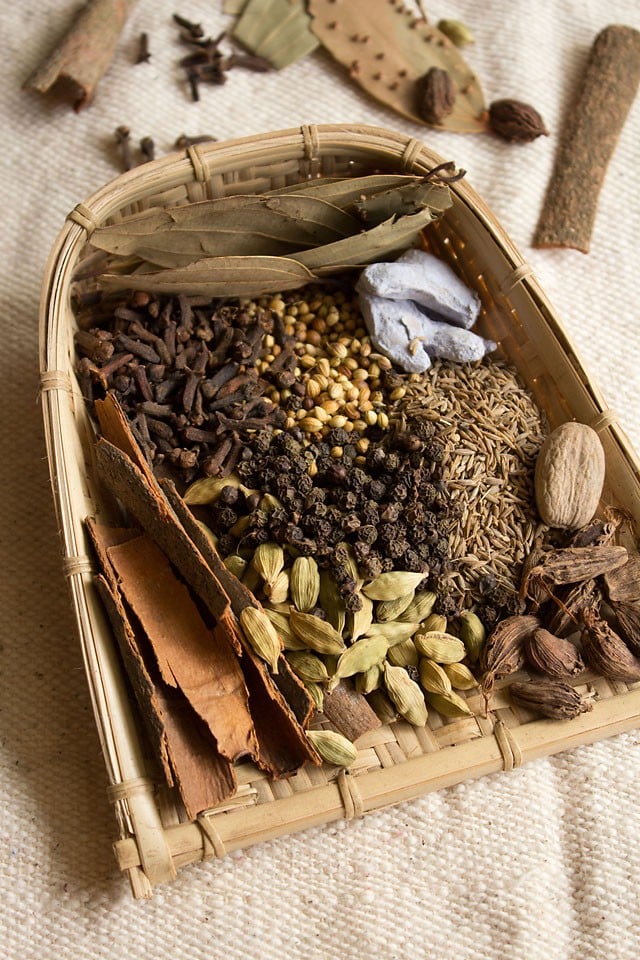
Not only the spices, add a ton of flavor to the dish, but some of the spices like cumin, carom seeds, fennel seeds help in digestion. For this reason, they are added to many recipes to aid digestion.
A few spices like green chillies or red chili powder add some pungency and heat to the dish. Depending on the recipe, the spices are added whole or in their powdered/ground form to the food.
There are many spice blends made by grinding whole spices in the Indian cuisine. Many families make their own spice blends like the essential garam masala, coriander powder, cumin powder, sambar powder, rasam powder etc.
Although you can buy the spice mixes from outside but homemade is always better. As they are free from fillers, additives and preservatives. Homemade spice blends have more intense flavors and a great fragrance.
Spices can be stored easily in a cool dry place in an air tight jars or containers. Sometimes a few spices can have mold or fungal growth on them depending upon the climate conditions. In this case you have to discard these spices.
You can also store spices for a longer time in the refrigerator in an air-tight container. Lastly, when buying spices it is better to buy organic spices and check the expiry date on the package. Make sure to finish the spices within their shelf period.
Get the names of spices, in English, Hindi and some more Indian regional languages in the table below. I hope these translations of the names of the spices in various Indian languages is useful to you.
I am also thankful to all the readers who have shared the name of spices in these regional languages through emails and the comments below. It is because of their contribution we have been able to expand this list and make it bigger.
Note that if you are using mobile phone or tablet then scroll the below table from left to right to see all the names.
List of Spices Names
| English | Hindi | Tamil | Kannada | Marathi | Konkani | Gujarati |
| Aniseeds, fennel seeds | Saunf | Sombu | Badishep | Variyali | ||
| Asafoetida | Hing | Perumkayam, perungaya | Hingu | Hing | Hingu | Hing |
| Basil seeds, sweet basil | Sabja seeds, subja, falooda seeds, tukmaria | Sabja | Tukmariya | |||
| Indian Bay Leaf | Tej Patta | Brinji elai | Tamalpatra, Tej Paan | Tamal patra | ||
| Big mustard seeds | Sarson | Sarsav | ||||
| Black cardamom | Badi elaichi | Periya elakkai | Mothi Ilaichi | Elcho | ||
| Black cumin seeds | Kala jeera | Karung seeragam | Kale Jeere | |||
| Black mustard seeds | Rai | Kadughu | Mohri | Rai | ||
| Black pepper | Kali mirch | Milagu | Menasinkalu | Kalimiri | Mari | |
| Black salt | Kala namak | Kale Meeth | Sanchal | |||
| Caraway seeds | Shahijeera | Perum seeragam | Shahajire | Shahjeera | ||
| Carom seeds, Thymol seeds, Bishops weed | Ajwain | Omam | Owa | Owa | Wonwo | Ajmo |
| Chilli powder | Lal mirch powder | Milagai tool | Lal Mirchi Powder, Tikhat | Marchu powder | ||
| Cinnamon | Dalchini | Lavanga pattai, pattai | Dalchini | Dalchini | Dalchini | Taja |
| Clarified butter | Ghee | Nei | Tup, Shuddha Toop | Ghee | ||
| Cloves | Laung, lavang | Krambu | Lavang | Laving | ||
| Coconut desiccated | Sukha nariyal ka choora/boora | Thuruvina thengai | Sukhe Khobre | Topranu khaman | ||
| Coconut dry | Sukha nariyal | Ularndha thengai | Sukhe Khobre | Copra, khopru | ||
| Coconut fresh | Nariyal | Thengai | Naral | Khopru, topru | ||
| Coriander powder | Dhania powder | Dhaniya podi | Dhane pood | |||
| Coriander seeds | Sabut dhania | Kottumalli Vidai, dhaniya | Dhane | Kothmir na dana | ||
| Coriander Leaves, Cilantro | Dhaniya, dhania | Kothamalli ilai | Sambhar, Kothimbir, Kothmir | Kothmari/kothmir | ||
| Cumin seeds | Jeera | Jeerakam | Jeere | Jeeru | ||
| Curry leaves | Kari patta, kadipatha | Karuveppilai | Kadi Patta, Godlimba | Limda, mitho limbdo | ||
| Dry fenugreek leaves | Kasoori methi | Kaaindha vendhaya ilaigal | Kasuri Methi | |||
| Dry ginger | Saunth, sounth, soonth | Sukku | Sunthi | Sunth | Sunthi | Sunth |
| Dry mango powder | Amchur | Mangai podi | Mavinkai Churu | Aamchur | Amchur | Amchur |
| Fenugreek seeds | Methi ke dane | Menthiyam, Vendhayam | Methya dane | Methi dana | ||
| Fenugreek Leaves | Methi | Vendhaya Keerai | Methi | |||
| Garlic | Lasan, lahsun, lahsan | Poondu | Lasun | Lasan | ||
| Fresh ginger | Adrak, adhrak | Inji | Ala | Adu | ||
| Dry ginger | Saunth, sonth | Sukku | Sunth | Sunth | ||
| Green cardamom | Hari elaichi, choti elaichi | Elakkai | Veldoda, Velchi | Elchi | ||
| Green chilli | Hari mirch | Pachai milagai | Hirvi mirchi | Chidiya marcha/lilu marchu | ||
| Ground nut, peanuts | Moongphalli, mungphali | Nila kadalei | Sheng dane | Shing | ||
| Holy basil | Tulsi | Tulasi | Tulas | Tulsi | ||
| Jaggery | Gur | Vellam | Bella | Gul | God | Gol |
| Palm jaggery | Tara gura, sharkara tada | Pana vellam | ||||
| Lime | Nimboo, nimbu | Elumichai | Limbu | Limbu | ||
| Cocum, kokum | Bhirinda, bhirnda | Kokam, aamsul | ||||
| Lime peel | Nimbu ka chilka | Elumichai thol | Limbachi Saal | |||
| Mace | Jayitri, javitri, javntry | Jaipatri | Jaipatri | Jaipatri | Jaipatri | Javintri |
| Mint | Pudina, podina | Pudina, pudhina | Pudina | Phudino | ||
| Nutmeg | Jaiphal | Jhadhikkai | Jaiphal | Jaiphal | ||
| Onion seeds, Nigella | Kalonji, kalaungi | Kalonji | Kalonji | |||
| Pine nuts | Chilgoze, nioze | |||||
| Dry pomegranate seeds | Anardana | Kaaindha maadhulai vidhaigal | Dadum na dana | |||
| Poppy seeds | Khus khus | Khasa khasa | Khas Khas | Khas khas | ||
| Raisins | Kismish | Kaindha dratchai / ularndha dratchai | Bedane | Suki draksh | ||
| Red chilli | Lal mirch | Milakai Vatral | Lal mirchi | |||
| Rock salt | Sendha namak | Kal uppu | Sendhe laun | Sindhalu Mithu | ||
| Rock flower, Stone flower | Pathar phool | Kalpaasi | Dagad phool | |||
| Salt | Namak | Uppu | Meeth | Mithu | ||
| Sesame seeds | Til | Ellu | Til | Tul | ||
| Saffron | Kunkuma, kesar, zafran | Kumkumappu | Keshar | Kesar | ||
| Screwpine, pandanus | Kewra | Rambai ilaigal | ||||
| Sichuan pepper, Szechwan pepper | Timur, tirphal, tephal, teppal | |||||
| Star anise | Chakriphool | Lavanga poo | ||||
| Sultanas | Munakka | Manuka | ||||
| Tamarind | Imli | Puli | Chincha | |||
| Turmeric | Haldi | Manjal | Halad | |||
| Vetiver | Khus | |||||
| Vinegar | Sirka | |||||
| Water melon seeds | Tarbuj ke beej | Tharboosani vidhaigal | Kalingad Bee |
Few More Similar Posts:
This Spices List post from the archives was first published on April 2009. It has been republished and updated on June 2021.
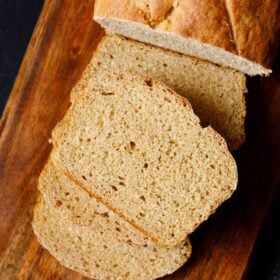
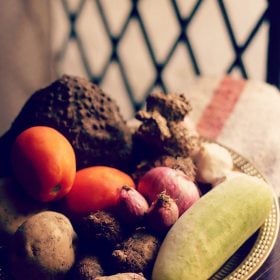
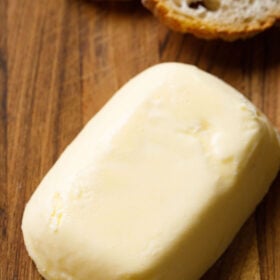
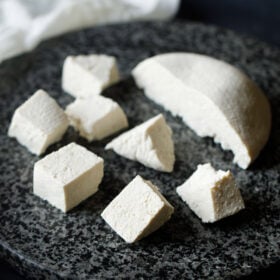








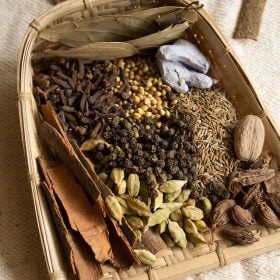
In Punjabi we say Maggan, a herb. what is the english name please?
Thanks
Long Pepper also called Pippali in Hindi.
how do you know this many
its awesome
That is because we use all these spices in Indian cuisine.
What is oregano in hindi?
There is no hindi name for oregano.
What is the English name of a masala ” Sund”
Dry ginger in root form and in powdered form it is dry ginger powder or ground ginger.
U dont remind sonf
It is listed and is the first spice in the table – named as saunf.
Poppy Seed is also known as Posto dana in hindi as well as in bengali.
Thanks a lot for the info and will update.
Hi Dassana
Excellent compilation of Indian spices along with their names in different languages. However, I am sad to see that you did not include Telugu in the list. You may know (or may not) Telugu is the second most widely spoken language in India after Hindi. Here is a historical fact: When British were ruling India, on the Indian currency there were only 4 languages printed – English, Hindi, Urdu and Telugu – nothing else. The reason being that even in those days, Telugu used to be the most dominant language in the entire south. Later in mid 1950s, India ditched the old British monetary system and introduced new currency. Since then, the government started printing all official languages of India on the currency.
Hi Rom, This is one of the earliest post of mine and was made when I had started the blog. Some Indian languages I did not add as the tables would have become too vast and at that time say 10 years ago there was no way I could format the tables well. Even now the table does not fit on a mobile screen. In the future I will add Telugu as well as other languages. Thanks for sharing the info and a piece of history. It is interesting to know. Thanks again.
Marathi Language
1) Bay Leafs- Tamalpatra
2) Mustard Seeds- Mohori/ Rai
3) Cardimon- Velchi
4) Black cumin seeds- Kale Jeere
5) Black Salt- kale Meeth
Thanks a lot Pooja for the spice names in Marathi. It will help the readers as well.
Sarson seed is not mentioned.
It is mentioned in the list.
what we call mangraila in english
mangraila are known as nigella seeds in english and kalonji in hindi.
Marathi names of some of the spices from your list:
1. Bay leaf – Tej Paan
2. Black Cardamom – Mothi Ilaichi
3. Black Cumin seeds – Kale Jeere
4. Black mustard seed – Mohri/Rai
5. Black Salt – Kala Meeth
6. Caraway Seeds – Shahjeera
7. Chilli powder – Lal Mirchi Powder
8. Clarified Butter – Shuddha Toop
9. Cloves – Lavang
10. Coconut Desiccated – Khobra Kiss
11. Green Coriander – Sambhar/Kothimbir
12. Cumin seeds – Jeere
13. Curry leaves – Curry Patta
14. Fenugreek – Methi
15. Sultanas – Manuka
thanks for taking time to write the names in marathi. i will update in some time. thanks again.
Harre
Murre
Pippar
In english
long pepper.
Hi.. I wish to give you some updates for few in tamil as follows,
Mustard – kadughu
Salt-uppu
Coconut dry – ularndha thaengai
Dry fenugreek leaves- kaaindha vendhaya ilaigal
Dry pomegranate seeds- kaaindha maadhulai vidhaigal
Screwpine/pandan leaves- rambai ilaigal
Watermelon seeds- tharboosani vidhaigal
thank you very much sharulatha. i have updated these in the post.
What to call kangi ke beej, what we use in panjari, in English?
i guess you are talking about melon seeds (called as magaz in hindi) that are added in panjari.
Hello Dassana,
I’m a big fan of your site, I use it whenever I would like to cook Indian food, or just to read about it. I have a question about shah jeera, which you call caraway in English on your site. I’ve googled it and some Indians call it caraway while others call it black cumin. In my Indian cookbook by Madhur Jaffrey she writes black cumin is shah(i) jeera. In the Indian food store, on the black cumin package, the label also says kala shah jeera. In the chart on this page, you list shah jeera and black cumin separately. Caraway (in Latin: carum carvi) has a very strong aroma, a bit like fennel and we use it a lot in several European cuisines and to flavour rye bread, potato dishes, etc. It smells very different from cumin. Black cumin (Latin name: Bunium bulbocastanum) looks a bit similar but has a very different aroma, more similar to cumin but to my nose, does not smell so pleasant, it has an earthier smell.
Could you please help me with this? Shall I use caraway or black cumin when you write shahjeera in your recipes? Thank you!
thank esther. in india, both kala jeera and shah jeera are sold separately. kala jeera has a bitter taste and used in ayurvedic medicines. whereas shah jeera is aromatic and pleasant. from what i know caraway seeds is shah jeera. i would suggest you to use caraway seeds and not black cumin. i hope i have managed to solve the confusion.